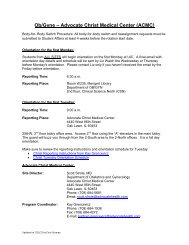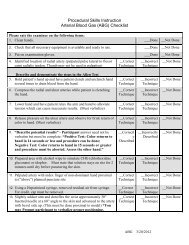Online ICU Guidebook ICU Basics Intensive Care Topics ...
Online ICU Guidebook ICU Basics Intensive Care Topics ...
Online ICU Guidebook ICU Basics Intensive Care Topics ...
You also want an ePaper? Increase the reach of your titles
YUMPU automatically turns print PDFs into web optimized ePapers that Google loves.
Home<br />
<strong>ICU</strong> <strong>Basics</strong><br />
<strong>Intensive</strong> <strong>Care</strong> <strong>Topics</strong><br />
Vasopressors<br />
Mechanical Ventilation<br />
Procedures + Calcs<br />
Core <strong>ICU</strong><br />
Core CCU<br />
P+C<br />
<strong>Online</strong> <strong>ICU</strong> <strong>Guidebook</strong><br />
<strong>ICU</strong> <strong>Guidebook</strong> | Procedures&Calculators | Paracentesis<br />
A paracentesis is a useful procedure for fluid analysis of ascites and diagnoses of SBP. Spontaneous bacterial peritonitis can be<br />
asymptomatic in nearly 40% of patients, hence prompt diagnosis and treatment of SBP is required. Always consider performing a<br />
paracentesis on hospitalized patients with ascites. Paracentesis can be performed safely at bedside, or ultrasound –guided via radiology.<br />
Indications:<br />
To diagnose SBP, cancer; or may be therapeutic for pts with<br />
diagnosed liver disease<br />
Contraindications:<br />
Uncooperative patient, uncorrected bleeding diathesis, acute<br />
abdomen that requires surgery<br />
intra-abdominal adhesions, distended bowel, abdominal wall<br />
cellulitis at the site of puncture, pregnancy.<br />
Supplies:<br />
This will vary at your site (JBVA/UIC). There are kits available at<br />
both institution. In general, this is waht you need:<br />
16 G Angiocath (or a spinal needle) x 1<br />
10 cc syringe x 1<br />
Thoracentesis kit tubing x 2<br />
Sterile gloves x 2<br />
Betadine swab x 3<br />
Sterile drape x 2<br />
4x4 sterile gauze x 4<br />
Band-aid x 1<br />
If therapeutic paracentesis:<br />
One-liter vacuum bottle x 5<br />
Proper tubing and wall suction kit<br />
Method:<br />
Read the following document: NEJM Paracentesis<br />
Procedure video: NEJM Videos in Clinical Medicine ><br />
Paracentesis<br />
What to send fluid for:<br />
cell count with diff (PMN > 250 = SBP) (lavender top)<br />
culture (fill each blood culture bottle (2) with 10cc of fluid)<br />
gram stain (separate syringe or tube)<br />
LDH, protein, albumin, amylase (gold top tube)<br />
Cytology (send as much as you can – fill a sterile jug)<br />
SAAG<br />
Calculate the serum-ascites albumin gradient (SAag): subtract<br />
ascitic albumin from serum albumin<br />
If > 1.1g/dl à portal hypertension<br />
If < 1.1g/dl à not portal HTN and less likely to have SBP<br />
(Note – if hemorrhagic, subtract 1 PMN for every 250 RBCs)<br />
PROCEDURE TEMPLATE<br />
PROCEDURE:<br />
paracentesis<br />
INDICATION:<br />
PROCEDURE OPERATOR:<br />
CONSENT:<br />
Informed consent was obtained after risks and benefits were explained<br />
at length.<br />
PROCEDURE SUMMARY:<br />
A time-out was performed. The area of the abdomen was<br />
prepped and draped in a sterile fashion using chlorhexidine scrub. 1%<br />
lidocaine was used to numb the region. The skin was incised 1.5 mm<br />
using a 10 blade scalpel. The paracentesis catheter was inserted and<br />
advanced with negative pressure under ultrasound guidance. Ultrasound<br />
images were permanently documented. No blood was aspirated. Clear<br />
yellow fluid was retrieved and collected. Approximately 65 mL of ascitic<br />
fluid was collected and sent for laboratory analysis. The catheter was<br />
then connected to the vaccutainer and liters of additional ascitic<br />
fluid were drained. The catheter was removed and no leaking was noted.<br />
50 g of albumin was intravenously during the procedure. The patient<br />
tolerated the procedure well without any immediate complications. Dr.<br />
____ was present during the procedure.<br />
ESTIMATED BLOOD LOSS:<br />
COMPLICATIONS: none<br />
Complications:<br />
Persistent leak from the puncture site<br />
Abdominal wall hematoma<br />
Perforation of bowel<br />
Introduction of infection<br />
Hypotension after a large-volume paracentesis<br />
Dilutional hyponatremia<br />
Hepatorenal syndrome<br />
Major blood vessel laceration<br />
Catheter fragment left in the abdominal wall or cavity




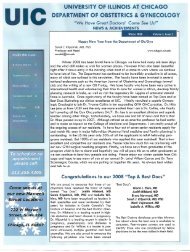
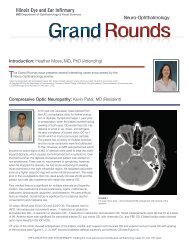
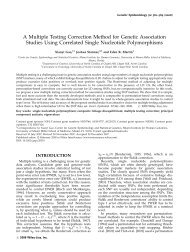
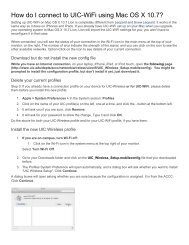
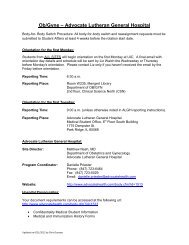

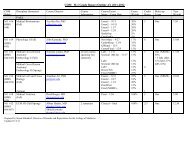

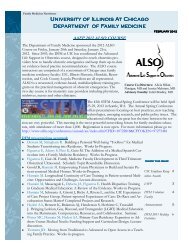
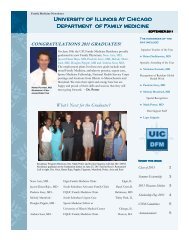
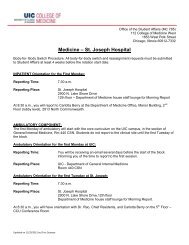
![CV Joan [W51] - University of Illinois College of Medicine at Chicago ...](https://img.yumpu.com/17336863/1/190x245/cv-joan-w51-university-of-illinois-college-of-medicine-at-chicago-.jpg?quality=85)
